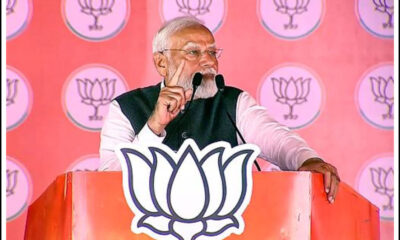Bollywood
A History of Violence
Published
7 months agoon

Why Tamil cinema, or Lokesh Kanagaraj, cannot replicate A History of Violence by David Cronenberg
Leo, according to Lokesh Kanagaraj, is a tribute to David Cronenberg’s 2005 film A History of Violence.
The older Tamil filmmakers, like AR Murugadoss, no longer have the luxury of making unauthorised remakes of Hollywood films in India. Without Christopher Nolan, Ghajini would not exist today. More scrutiny is placed on Indian cinema the more it is exposed to the outside world (and vice versa). Therefore, it seems sense that Lokesh Kanagaraj credits David Cronenberg’s 2005 film A History of Violence at the beginning of Leo. However, it wasn’t essential. A History of Violence itself did not begin with a novel story. It’s one of the oldest action-hero stories ever told, about a man with a horrific past. Many films (even before A History of Violence) are derivatives of this age-old story (that has been exploited by filmmakers and novel authors all over the world), from Amitabh Bachchan’s Hum to Rajinkanth’s Baashaa to Kamal Haasan’s Vikram.
As a result, neither David Cronenberg nor John Wagner, creator of the graphic novel of the same name (on which A History of Violence is based), own the tale. Furthermore, Cronenberg’s film is about the treatment rather than the subject. It’s about the main character, Tom Stall (Viggo Mortensen), also known as Joey. It is about determining who the true protagonist is. Is he the humble family man who owns a little cafe? The individual who fought and defeated the demon within him. Is he the monster with a passion for killing, dressed in sheepskin? A History of Violence is a psychological drama rather than an action movie. We don’t get such musings while seeing Leo because it’s a typical Tamil star vehicle that aspires to be something more than it is.
Read also:-What Happened The Night Soumya Vishwanathan Died? A Car Chase And A Gunshot
Let it be clear that Lokesh Kanagaraj’s Leo is not an attempt to imitate David Cronenberg (that would have been a far better film). Lokesh tries to pitch A History of Violence as a Tamil masala picture, although with less spice. He should have gone for Bob Odenkirk’s Nobody instead, because A History of Violence has a texture that is difficult to achieve in an industry like Tamil cinema, especially with such a big actor as Vijay. In some ways, Tamil cinema is a rigged game. Before the writer even starts to write, many things have already been decided. In one of the many promotional interviews, Lokesh claimed that Leo is entirely his film. That is designed to imply that he hasn’t compromised in any way. However, the director later clarifies that songs are included in movies to satisfy a marketing requirement. That’s a component of the game being rigged.
Second, lust and sensuality play a significant role in A History of Violence. In one scene, Maria Bello’s character Edie Stall brings her husband Tom to her parents’ house for hot sex. To add some interest, she dons her school’s sports shirt before going into the attic room. Beyond just being erotic, there is plenty to this. Edie uses it as a means of recreating her adolescence with her spouse, who wasn’t alive at the time. It also addresses the secret flaws of a devout wife and mother of two children. It is about what is beneath the surface. In essence, Cronenberg’s film is concerned with the very nature of mankind. Later, once Tom’s true color is revealed, sex serves as a bridge to reunite Edie and Tom. Kinky sex gives way to angry sex. Edie ultimately learns to ‘know’ Joey, despite the fact that the two characters are not reconciled. Trisha in a college jersey reenacting the sequence in Leo is tough to fathom since it would be too much for Tamil cinema. Instead, we are to regard the kissing moment in the film as daring.
However, these are partially due to cultural constraints rather than Lokesh Kanagaraj’s flaws. Leo received criticism for endorsing smoking. That is still where we are. Although society can be held accountable for these restrictions, nothing explains how Lokesh wrote his Parthiban and Leo. The main issue with Leo is that there is no distinction between it and Parthi. I don’t anticipate a cowardly Ambi becoming an Anniyan, but there must be a separation between the two. From the start, Parthi is every bit as vicious as Leo.
He attacks everyone he battles mercilessly, which is something Parthiban, not Leo, would do. The contrast between A History of Violence and Leo lies in the writing’s subtlety. In the American version of the movie, Joey is never seen laughing or enjoying the bloodshed. Although he is always called the “crazy one” by the characters. Viggo Mortensen’s expression is minimum all the time. He still emits remorse and regret even in the end, when the family accepts him for who he is. Leo, on the other hand, closes on a joyful note that negates the entire purpose. The tale is no longer the main focus. No matter whether the hero is a good guy or a bad guy, it all comes down to him.
You may like
-


On the Citizenship Amendment Act (CAA), PM Narendra Modi challenges Congress and the SP
-


Shortly After Slovak PM’s Assassination, As Crowd Held Gunman
-


Vladimir Putin, the leader of Russia, makes a state visit to China as a symbol of the alliances’ solidarity
-


NASA: Bright, tiny, plant-like creatures discovered in the Celtic Sea
-


Earth’s North Pole is moving more quickly
-


Following the helium leak, Starliner is now aiming for a May 21 launch.

